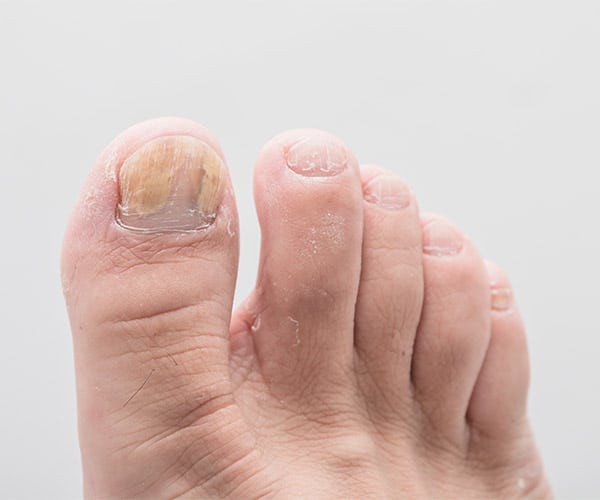Nail Fungus
Nail Fungus
Nail fungus is caused by a fungal spore infection of the toenails. Fungus is most common in a dark, warm, moist environment, which is why it’s a common condition for people to experience on their toenails. The fungi feed on the nail’s protein, keratin.
Some infections are small and easily contained, while with other patients it can spread quickly. When the fungal infection moves away from the toenail onto the skin on or between the toes, it is known as athlete’s foot. Often, these two conditions go hand-in-hand as both these infections spread easily.

- Symptoms
- Causes & Prevention
- Treatment
Nail Fungus Symptoms
The first nail fungus symptom that people notice is white, yellow, or brown discoloration and streaking in the nail. This can start out very small but can often spread to the whole nail or other nails on the foot.
As the infection progresses, the nail can begin to lift from the nail bed and nails can become brittle or ragged. They can become dull and crumble along the edges. They can also appear distorted and be uncomfortably thick. Some patients experience pain as the shape and size of the toenail changes due to the infection.
Nail Fungus Causes and Prevention
There are a variety of causes of nail fungus and many ways to prevent an infection. While nail fungus can affect fingernails as well as toenails, it is much more commonly found on toenails because there is less blood flow to the feet than to the hands. Our bodies aren’t able to detect infections on the toes as promptly as on the fingers, making it easier for the fungus to develop and spread.
Nail fungus is caused by exposure to fungal spores in any environment. You can become infected when barefoot around public places like pools, gyms, or showers. Sharing a shower or bathroom with an infected family member can also lead to your own infection. Trimming nails with instruments that have not been properly sanitized and exposed to the fungus also puts you at risk.
A damaged nail is more susceptible to a fungal infection. Feet that are often wet or in shoes that don’t have proper airflow are more likely to harbor a nail fungus.
There are many things you can do to prevent nail fungus:
- Wear footwear in public places
- Ensure sanitized instruments are used when caring for nails
- Keep bathroom and shower areas clean
- Wear clean socks daily
- Keep feet clean and dry
- Wear shoes that allow for airflow
- Avoid trauma to nails
Nail Fungus Treatment
Nail fungus doesn’t usually go away by itself, but luckily, it can often be treated easily when caught early enough.
If left untreated, nail fungus can spread to other nails very easily. It can also spread to your skin, causing athlete’s foot and other discomfort. It’s also very easy to infect other people through exposure, whether in your own household or in public places.
If nail fungus treatment is not received quickly enough, the nail can become permanently damaged and it is much more difficult to clear the infection. It’s important to get nail fungus treatment as soon as you notice the infection.
Treatment options include:
- Laser treatments
- Topical ointments
- Oral medication
A chiropodist can also thin and clear the damaged nail to alleviate discomfort and prevent the spread of the infection.
If you’re suffering from toenail fungus, please contact us. The chiropodists at Collective Foot and Wellness Clinic can find the treatment option that’s best for you and help you clear the infection. Don’t risk permanent damage by delaying and waiting.
